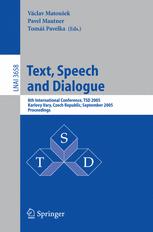

Most ebook files are in PDF format, so you can easily read them using various software such as Foxit Reader or directly on the Google Chrome browser.
Some ebook files are released by publishers in other formats such as .awz, .mobi, .epub, .fb2, etc. You may need to install specific software to read these formats on mobile/PC, such as Calibre.
Please read the tutorial at this link: https://ebookbell.com/faq
We offer FREE conversion to the popular formats you request; however, this may take some time. Therefore, right after payment, please email us, and we will try to provide the service as quickly as possible.
For some exceptional file formats or broken links (if any), please refrain from opening any disputes. Instead, email us first, and we will try to assist within a maximum of 6 hours.
EbookBell Team

4.8
24 reviewsTheInternationalConferenceTSD 2005,the8theventin theseriesonText,Speech,and Dialogue, which originated in 1998, presented state-of-the-art technology and recent achievements in the ?eld of natural language processing. It declared its intent to be an interdisciplinary forum, intertwining research in speech and language processing with its applications in everyday practice. We feel that the mixture of different approaches and applications offered a great opportunity to get acquainted with the current act- ities in all aspects of language communication and to witness the amazing vitality of researchers from developing countries too. The ?nancial support of the ISCA (Inter- tional Speech Communication Association) enabled the wide attendance of researchers from all active regions of the world. Thisyear’sconferencewaspartiallyorientedtowardsmulti-modalhuman-computer interaction (HCI), which can be seen as the most attractive topic of HCI at the present time. In this way, we are involved in a rich complex of communicative activity, facial expressions, hand gestures, direction of gaze, to name but the most obvious ones. The interpretationof each user utterancedependson the context,prosody,facial expressions (e. g. brows raised, brows and gaze both raised) and gestures. Hearers have to adapt to the speaker (e. g. maintainingthe theme of the conversation,smiling etc. ). Research into the interaction of these channels is however limited, often focusing on the interaction between a pair of channels. Six signi?cant scienti?c results achieved in this area in the USA, Japan, Switzerland, Germany, The Netherlands, and the Czech Republic were presented by keynote speakers in special plenary sessions. Further, approx.